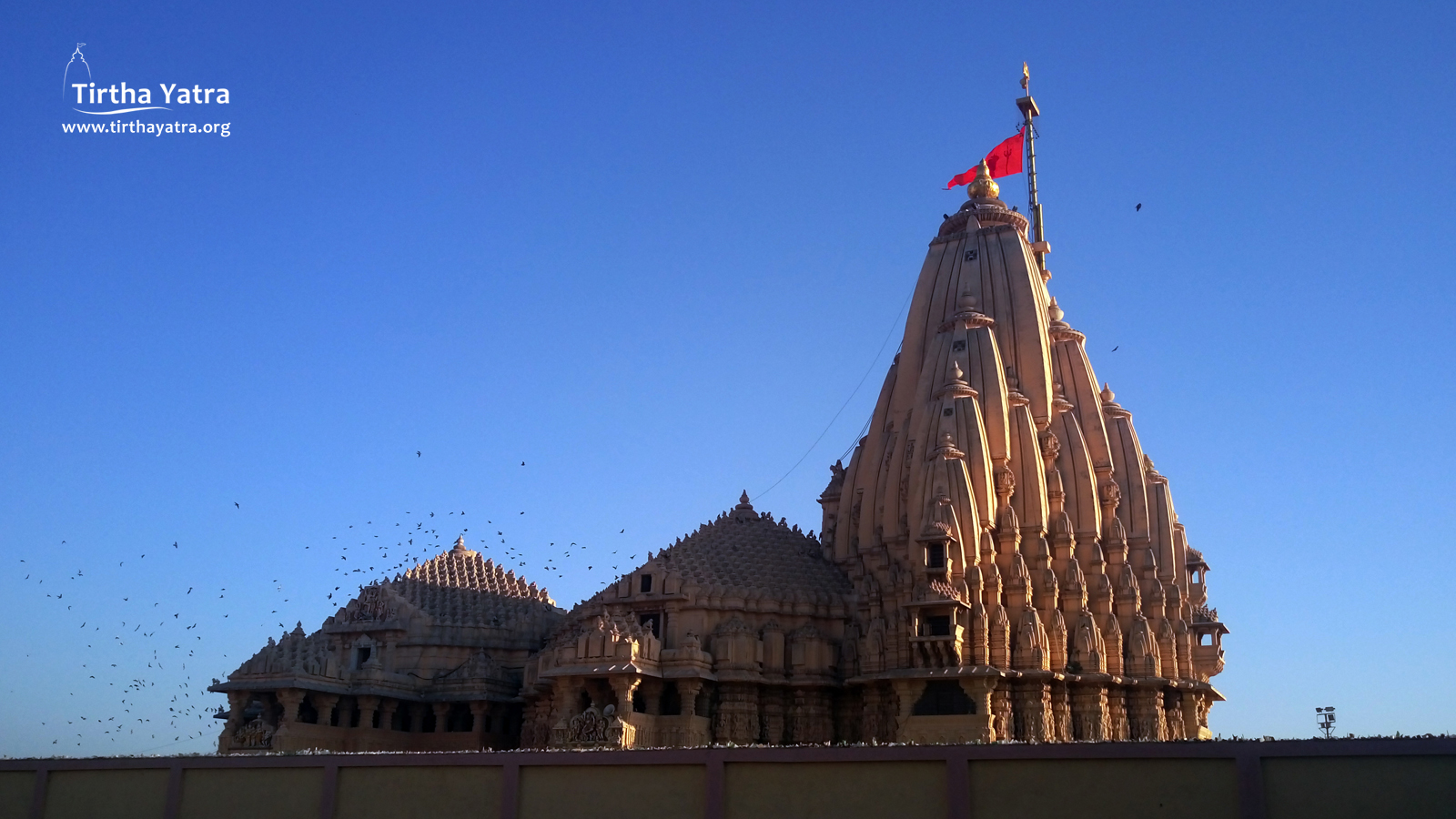
Somnath Temple is situated in Prabhas Patan which is 7 kms from Veraval on the bank of Arabian Sea in the western coast of Gujarat in India. This region is also called as Saurashtra. The Somnath Jyotirlinga in the Somnath temple is the first jyotirlinga out of the twelve jyotirlingas in India. It is considered to be the most important jyotirlinga. This place is also known as Prabhasa-kshetra because Chandra, the moon-god received his effulgence at this place. Prabhasa means effulgence.
Prabhas-kshetra is considered to the one of the most important pilgrimage centers in India. This place has been very closely associated with Mahabharata as Pandavas would come here. Yadavas would also visit this place regularly. It is from here that the Supreme Lord Sri Krishna left to His own abode – Goloka. It is believed that the Sage Agatsya drank the entire ocean from Prabhas.
How Somnath Jyotirlinga Manifested
A literary meaning of Somnath is ‘Lord of the Moon’. Soma means the Moon and nath means the Lord. The origin of Somnath is mentioned in the chapter 14 of Kotirudriya Samhita of the Shiva Purana and the Prabhasa-khanda of Skandha Purana.
Prajapati Daksha married his twenty seven daughters to Chandra. All his daughters were happy and satisfied to receive Chandra as their husband. But their happiness did not last long because amongst all of them Chandra was more attached to Rohini. He started taking great care of Rohini and neglected his other wives. Being sad at this behavior of Chandra, they complained to their father Daksha. On hearing the sad plea of his daughters, Daksha advised Chandra to treat all of them equally. However Chandra did not listen to his father-in-law’s advice. Although advised thrice, Chandra did not realize his mistake. This angered Daksha, who cursed him to lose his effulgence.
After Chandra lost his effulgence, there was a great calamity in the universe because all the herbs and trees are maintained by the effulgence of Chandra. Seeing the world in this condition, all the sages approached Lord Brahma for a solution. Lord Brahma advised Chandra to visit Prabhasa Kshetra and perform austerities to please Lord Shiva. Thus hearing the instructions of Brahma, all the sages and demigods took Chandra to Prabhasa-kshetra. There they made a shiva-linga, worshiped it with the water of River Saraswati and the other holy rivers and left Chandra to perform the penances.
Chandra performed sincere penance for six months and pleased Lord Shiva. Lord Shiva appeared before him and awarded him a boon. Chandra requested Lord Shiva to save him from the continuous loss of his effulgence. Lord Shiva awarded a boon to Chandra, that he would reduce every day by a digit for fifteen days and then again rise for the next fifteen days. Hearing this blessing bestowed on Chandra, all the demigods and the sages were very pleased. They thanked Lord Shiva and requested him to stay in that same place to receive the worship of his devotees and bless them. Hence the shiva-linga here is known as Somnath or Someshwara. Demigods then established a kunda here which is known as Someshwara Kunda. It is believed that anyone who takes a dip in this kunda continuously for 6 months is rid of all the diseases. Chandra built a temple of Gold for Somnath. Later in Treta-yuga Ravana rebuilt the temple with silver and then Lord Krishna rebuilt the temple with Sandalwood in Dvapara-yuga. In Kali-yuga this temple was re-constructed by the King Vikramaditya.
The Vedic scriptures say that the installation of original Shiva-linga was done on the third brighter day of Shravana month during the tenth Treta-yuga of Vaivasvata Manavantara and the temple was built approximately 79,925,105* years ago.
saurashtradeshe vishade atiramye jyotirmayam chandrakalavatamsam
bhaktipradanaya kripavatirnam tam somnatham sharanam prapadye
(Dvadashajyotirlinga-stotram)
The Unmatched Glory of Somnath
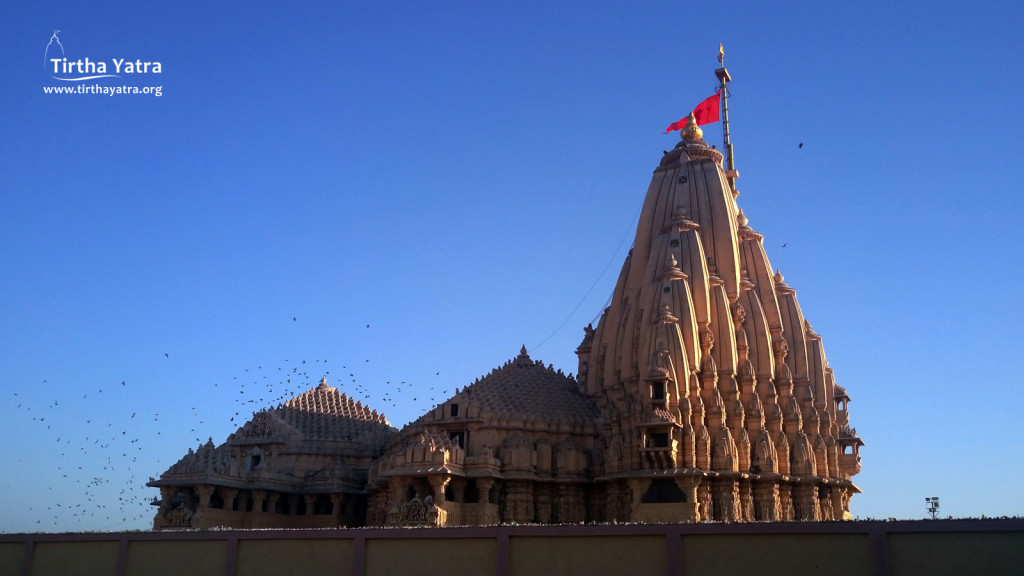
Since time immemorial Somnath Temple has attracted innumerable pilgrims who have donated unimaginable wealth to the temple. This made the temple very opulent. Every day for the worship of Lord Somnath scented water from Haridwar and Prayag Kashi. The flowers for worship were brought from Kashmir. Around one thousand brahmanas were engaged in the worship of the Lord. About three hundred and fifty dancers and musicians were engaged in the service of Lord Somnath in the temple. Around ten thousand villages were under this temple.
This opulence attracted Muslim rulers who wanted to plunder away its wealth. Since ages this temple has been desecrated and consecrated many times by many rulers.
How Somnath Temple Was Destroyed And Reconstructed several times
The First Attack
 In AD 1013-1026 Mahmud of Gizni brought his army in order to loot the Sri Somnath Temple. He plundered all the diamonds, pearls, and other precious stones which were in the temple. He plucked the precious stones from the walls of the temple and then burnt it. He also broke the original shiva-linga. Being afraid of the Hindu kings, he stayed there only for 18 days and left the place very soon. He was then attacked by the Bhoj of Malav and Bisaldev of Ajmer. By the time he reached Gizni, he was left with just 2000 soldiers and died along with all his soldiers, completely disappointed and frustrated.
In AD 1013-1026 Mahmud of Gizni brought his army in order to loot the Sri Somnath Temple. He plundered all the diamonds, pearls, and other precious stones which were in the temple. He plucked the precious stones from the walls of the temple and then burnt it. He also broke the original shiva-linga. Being afraid of the Hindu kings, he stayed there only for 18 days and left the place very soon. He was then attacked by the Bhoj of Malav and Bisaldev of Ajmer. By the time he reached Gizni, he was left with just 2000 soldiers and died along with all his soldiers, completely disappointed and frustrated.
After Mahmud went away, the temple was rebuilt and restored to its beauty collectively by King Navaghan of Junagadh, King Bhimadev of Gujarat, King Bhoj of Malav and King Bisaldev of Ajmer. They also re-made and re-installed the shiva-linga in this temple.
The Second Attack
In the year 1218, the soldiers of Alauddin Khilji, the sultan of Delhi attacked Patan under the leadership of Alapkhan in order to loot Gujarat. In this war, the last Hindu king of Gujarat, Karandev got defeated and Alapkhan established the rule of Delhi Sultanate on Patan. He then destroyed Khambhat and then attacked Prabhas. He destroyed the Sri Somnath Temple and again broke the Shiva-linga. He took the destroyed Shiva-linga along with him and also looted the wealth of Prabhas. He took many prisoners with him. After his soldiers left, Rah Navghan IV of Junagadh fought the muslims and chased them away from Prabhas. He then renovated the temple and installed the Shiva-linga.
The Third Attack
In the AD 1316, after the death of Gyasuddin Tughlaq, the sultan of Delhi, his son Mahmad was crowned as the King. He imposed cruelty on his subjects and the ministers so much that his ministers turned traitors. Amongst these, one minister Taghi fled and took shelter under the King Rah of Junagadh. Mahmad chased Taghi till Junagadh and attacked it. One part of his army was sent to Somnath to destroy the temple. The temple was protected by the local king Vinjal who died protecting the temple. And thus the temple was destroyed the third time.
The Fourth Attack
Firoz Shah Tughlaq the next king after Muhammad Tughlaq was defeated badly in the battle of Sindh and thus the situation in Gujarat was completely disorganized. To take advantage of this situation, King Meghraj of Prabhas with the help of Rah Khengar of Junagadh chased away the soldiers of Sultan and re-installed the Shiva-linga. As this news reached Zaffarkhan, he attacked Prabhas with his vast army. During this battle, King Meghraj was killed and thus the temple was destroyed the fourth time.
The Fifth Attack
In AD 1377, King Bharm, brother of King Meghraj re-installed Shiva-the linga and in AD 1386 he strengthened the fortified wall of Prabhas in order to hold any kind of attack. Till AD 1395, the worship of Somnath was being performed but in the same year Zaffarkhan attacked and destroyed the temple along with the Shiva-linga. And thus the temple was destroyed the fifth time.
The Sixth Attack
Zaffarkhan had made an elaborate arrangement in order to stop the worship of Somnath. However devotees of Lord Somnath were very determined. They constructed the temple and begun the worship of Somnath. However in AD 1402, Zaffarkhan again attacked Prabhas and destroyed the temple and the linga the sixth time.
The Seventh Attack
After Zaffarkhan, the temple of Somnath was again renovated. This was far from the tolerance of Zaffarkhan. He attacked the temple again with his vast army. A ghastly battle broke out in which the last king of Prabhas Brahmadas Vijayaraj was killed. This ended the king’s dynasty. Prabhas was thus looted and the temple was destroyed for the seventh time.
In the year 1419, Ahmadshah, the son of Zaffarkhan came to Prabhas and spoilt whatever was left by his father. However his soldiers were chased away by Rah III of Junagadh, who then renovated and established the Shiva-linga of Sri Somnath between the year AD 1451 to AD 1456.
Later Aurangzeb tried to attack Somnath temple twice however he died before he could succeed in his attempt. In the year 1782, Queen Ahilyabai of Indore constructed a new temple of Sri Somnath. The work began in 1782 and got completed in 1788. In AD 1810, Vittalarao Devaji of Gayakwad of Badode, got carvings done in the temple and constructed the dharma shala. During the same year, many temples in the surrounding were renovated.
In AD 1806, British started involving in the administration of this area. At that time, the king of Badode wrote to East India Company that there should not be any obstacles in the activities of Sri Somnath temple. In order to execute this request, East India Company sent Captain Macmardo to Junagadh. In 1813, the British wrote a commission under the administration of Connel Hunter recording the authority of Hindus over the temple clearly. This commission was accepted by the Central Government after minor changes. There was a misunderstanding over this commission and the temple was lightly attacked on 19th July 1893.
Until the year 1947, the situation was peaceful in Somnath. Then Nawab of Junagadh decided to join Pakistan during the partition. The subjects opposed this decision and finally the Nawab ran away to Karachi. Junagadh then accepted the rule of Independent India. On November 14th, Sri Sardar Vallabhbhai Patel visited Somnath and declared to renovate the temple. He also inspired to form the Somnath trust. Digvijayasingh, the king of Jamnagar was the first president of this trust. The trust started constructing the temple. On 11th May 1951, the temple was inaugurated by Sri Rajendra Babu and since then the Somnath temple has been one of the major pilgrimage centers in India.
The current temple of Somnath is constructed in a Kailasha Maha Meru Prasad Style signifying the Kailash Mountain, the abode of Lord Shiva. The temple consists of the sanctum-sanctorum, the assembly hall, the dancing hall with a 150 feet taller gopura. The kalasha atop the gopura weighs 10 tons and the flag post is 27 feet tall. Some historians also believe that before the attack of Mahmud of Gizni, the temple was already attacked and destroyed twice.
Somnath Temple Timings
The temple is opened from 6AM to 9PM. The arati is performed at 7AM, 12PM & 7PM.
How to reach Somnath Temple
Recently a railway station is built in Somnath however very few trains commute to this railway station. The nearest bigger railway station is Veraval. Veraval is well connected by train from other major cities in Gujarat like Junagadh, Ahmedabad, etc. From Veraval one can catch an auto to reach Somnath. One can also reach Somnath via State Transport, taxi from Junagadh, Ahmedabad and Dwarka.
References
Somnath Katha Darshana by Megha Publication, authored by Sri Vijay Panchal
The Jyotirlingas compiled by Sri Shanti Lal Nagar
* This date is according to Swami Sri Gajanand Saraswatiji, the chairman of Srimad Adya Jagadguru Shankaracharya Vedic Shodh Samsthan in Varanasi.
6

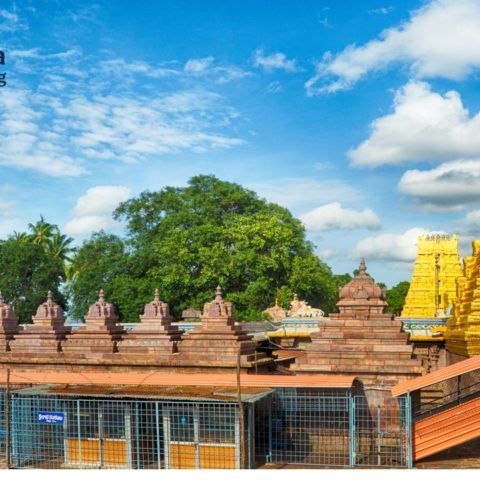
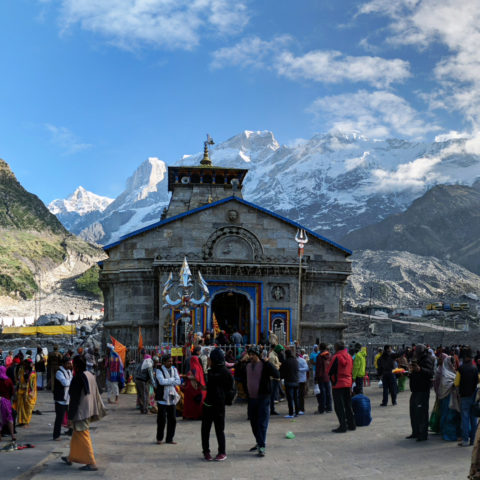
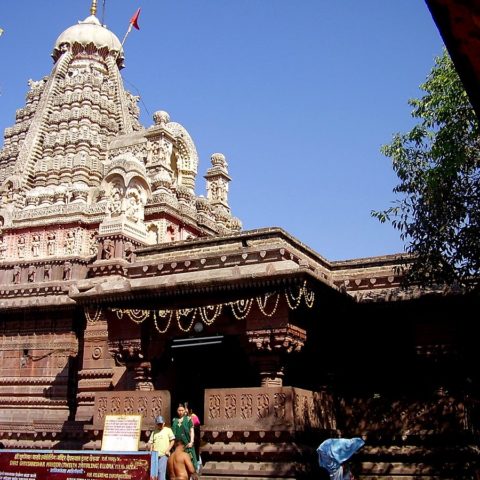










6 Comments On Somnath Temple – The Eternal Temple
P.Ramesh Sharma
How sad the first Jyothirlinga and Somnath Temple of Lord Shiva distroyed by Muslim invaders several times because no unity in hindus right from 2000 years. At least it is time to unite otherwise hindus will perish in India. of course Great Hinduism will spread all over the world in near future
Rasa
Hare Krishna! All glories to Sri Somnath! What a wonderful article and fascinating history of one of the most Holy places on the Earth. Thank you very much.
Thank you. Hare Krishna
Nice informative articles on all famous temples gmail.cim By AgraniKrishnaDas of Thithayatra.superb
Kirti Ruparelia
I would like to visit all 12 Jyoti Lingams and I need guidance from to start first and to reach all the Temples systematically. Please email me your guidance. Will appreciate a lot.
Thank you.
Dear madam, we request you to send an email to bookmyyatra@tirthayatra.org. Thank you